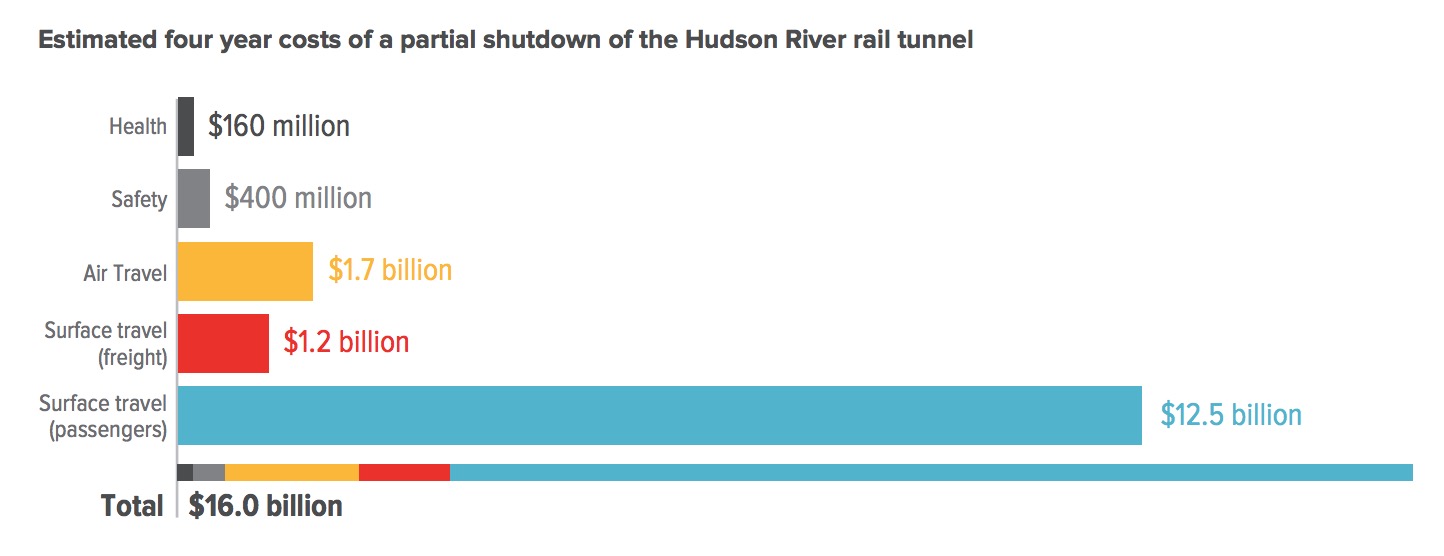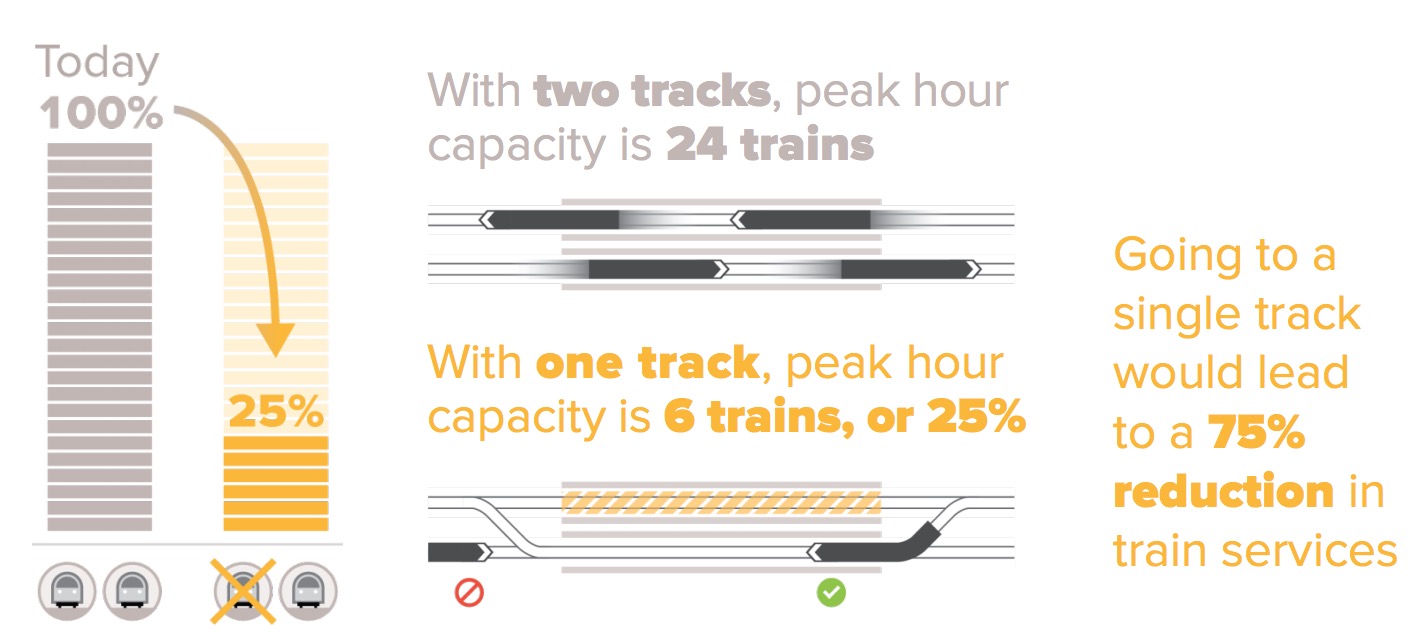REGIONAL PLAN ASSOCIATION (RPA)
What Would Happen If We Lost One of the Two Rail Tracks Under the Hudson River?
 Every day, 200,000 passengers ride an Amtrak or New Jersey Transit train through a 110-year old, two-track tunnel under the Hudson River that was badly damaged by Superstorm Sandy. The tunnel is the only passenger rail link that connects Manhattan, the nation’s largest job center, with its western suburbs. It is also a bottleneck for the Northeast Corridor running from Washington, DC to Boston, by far the most heavily used intercity rail line in the United States. The number of passengers served by this tunnel has grown rapidly over the last two decades, and is expected to continue growing as the economy expands.
Every day, 200,000 passengers ride an Amtrak or New Jersey Transit train through a 110-year old, two-track tunnel under the Hudson River that was badly damaged by Superstorm Sandy. The tunnel is the only passenger rail link that connects Manhattan, the nation’s largest job center, with its western suburbs. It is also a bottleneck for the Northeast Corridor running from Washington, DC to Boston, by far the most heavily used intercity rail line in the United States. The number of passengers served by this tunnel has grown rapidly over the last two decades, and is expected to continue growing as the economy expands.
Because the damage from Sandy cannot be fully repaired without closing down each of the two tubes in the tunnel, the only way to avoid several years of sharply reduced service is to build a second tunnel that could keep full service running while the existing tunnel is repaired. But it will take several years to construct a new tunnel, and full construction cannot start until funding is secured. Each day that passes without agreement on funding for a new tunnel makes it more likely that a tunnel shutdown will happen first.
This would place enormous stress on the already overburdened transportation network in the Northeast, from interstate highways to international airports. Because passengers who would no longer be able to take a New Jersey Transit (NJT) or Amtrak train would spill over into already crowded trains, buses, highways and planes, the entire transportation network would become more congested. Employees would be late to work and more stressed when they arrive. Meetings would be missed. Family dinners would be late. Both residential and commercial property values would decline as prime locations served by rail become less desirable.
The shutdown would cost the national economy $16 billion over four years.
More than half of this cost would come from the time lost by workers from longer daily commutes. These wage costs alone are the equivalent to the loss of 33,000 jobs per year. Added auto costs for those needing to drive, higher air fares, higher freight delivery costs, and costs associated with health and safety risks also contribute. The impacts would be greatest in New Jersey and New York, but they would reverberate throughout the Northeast and the U.S. This estimate does NOT include several costs that were not calculated due to insufficient data:
- Buffer times that people would build into their travel times because service would be too inadequate or unreliable to consistently arrive at work, meetings or other destinations on time
- Bus trips that would be longer and less reliable due to traffic congestion
- Additional wear and tear on roads and other infrastructure
- Compound impacts if other transit links (PATH, Port Authority Bus Terminal, subways), Northeast airports or interstate highways experience disruptions
- Health and productivity impacts of increased mental and physical stress caused by congested and unreliable travel
- Delays in ambulance, police, fire and other emergency response vehicles
Nearly half a million people would have longer, less reliable and more crowded commutes, losing hours of productive, personal and family time and often putting their jobs at risk:
- 38,000 New Jersey Transit riders would need to find other ways to get to work.
- As many as 170,000 PATH and bus riders would be delayed by more crowded trains and congested roadways.
- 245,000 drivers, nearly half of whom drive to locations outside of Manhattan, would have longer commutes. More than half of these would see their daily commutes increase by more than 30 minutes.
Displaced Amtrak riders would further crowd airports, increasing DC to NYC air fares by as much as 65% and potentially doubling fares between Baltimore and New York.
Most business travelers would choose to fly if they can’t get on a train that would get them to their destination on time. Because there is a cap on the number of flights in and out of New York’s airports, the increased demand would push up ticket prices, with few seats left for those unable or unwilling to pay the higher fare.
Truck delays would cost the Northeast economy over $1 billion.
Congested highways would create longer trips, many of which originate in Pennsylvania, central New Jersey or upstate New York. The added costs of delivering goods would be passed onto consumers.
Home owners would see their property values dip by $22 billion.
Homes with better access to jobs are worth more. In fact, fully 40% of homes in New Jersey are within two miles of a train station. These homes would decline in value, just as values increased when service was added to NJT in the last two decades. These would be most heavily concentrated in northern New Jersey counties such as Essex, Union and Middlesex, and the towns and school districts where these homes are located would experience a drop in tax revenue.
Owners of commercial property—offices, stores, health and education facilities, factories and warehouses— would also see a decline in property values.
This is more difficult to calculate than changes in homeowner values, and beyond the scope of this study to calculate. However, businesses that rely on workers, clients, tourists or other customers who would be affected by the shutdown would absorb some of the costs, putting downward pressure on commercial property values. This would be most acute in Manhattan, but would affect other locations as well, leading to a decline in local tax revenues.
38,000 additional car crashes and more air pollution could result in 90-100 additional deaths.
Because more people would be spending more time on the road, the number of auto and truck accidents would rise, along with pollutants that increase premature deaths. The two million additional tons of carbon dioxide that would be produced over four years is the equivalent of flying 2.6 million people from New York to San Francisco.
Federal, state and local governments would lose $7 billion in tax revenue.
This includes $1.5 billion in federal taxes and over $1 billion in states outside of New York and New Jersey.
Both regional and national global standing as a place to live and work would suffer an incalculable loss.
Business surveys that rank cities such as New York and Washington as attractive locations to do business routinely list poor quality infrastructure as their Achilles heel. The deterioration of rail, subways, bridges and tunnels in these cities and across the U.S. adds to this perception and is already one of the greatest risks to continued economic growth. A partial shutdown of the Northeast’s main artery would be a dramatic event that could solidify the perception and worsen the global position of some of the nation’s most productive regional economies.
Besides preventing this crisis, building a new tunnel would provide enormous long-term benefits to the nation and the Northeast.
It would vastly improve both commuter and intercity travel, make it possible to add new rail service, and greatly expand growth in jobs and incomes while improving energy efficiency.
Download full version (PDF): A Preventable Crisis
About Regional Plan Association (RPA)
www.rpa.org
“At RPA, our professional researchers and regional planners seek to improve the prosperity, sustainability and quality of life in the New York-New Jersey-Connecticut metropolitan region through work in transportation, economic development and real estate, environment and open space and more. We also provide leadership on transportation, environmental and economic-development issues in the Northeast and across the U.S.”
Tags: Hudson River Rail Tunnel, Hudson River Rail Tunnel Shutdown, New York City, Regional Plan Association, RPA








 RSS Feed
RSS Feed